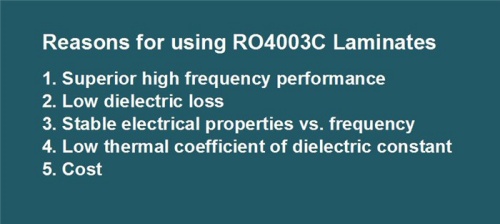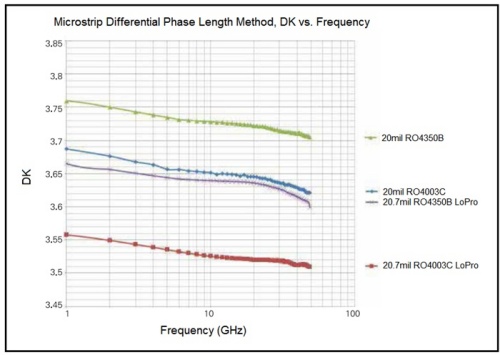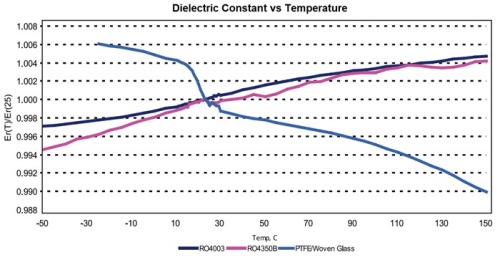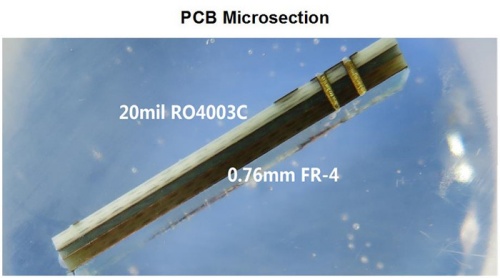| |
|
|
|
|
|
|
|
|
Rogers 4003C PCB with 8mil, 12mil, 20mil, 32mil and 60mil Coating with Immersion Gold, Silver, Tin and OSP |
|
|
(PCBs are custom-designed; shown images and specifications are for illustrative purposes only.) |
|
|
Hi, Everyone, Today, we’re excited to introduce high-frequency PCBs built with RO4003C laminates.
RO4003C is a hydrocarbon resin ceramic-filled laminate reinforced with woven glass cloth, developed by Rogers Corporation. It offers electrical properties comparable to PTFE, while its processability closely resembles that of epoxy resin (glass cloth) materials.
Now, let’s explore the five key advantages of RO4003C laminates.
|
|
|

|
|
|
1. Enhanced high-frequency performance
RO4003C materials consist of hydrocarbon ceramic-filled laminates, distinguished from PTFE, specifically engineered to deliver exceptional high-frequency performance.
2. Minimal dielectric loss
Achieving low loss translates to superior electrical performance, enabling applications to operate at high frequencies efficiently.
3. Consistent electrical properties across frequency ranges
RO4003C material exhibits the characteristics suitable for RF microwave circuits, matching networks, and controlled impedance transmission lines. Its dielectric constant remains stable within a wide frequency spectrum (as illustrated in the chart comparing dielectric constant vs. frequency).
|
|
|
 |
|
4. Exceptionally low thermal coefficient of dielectric constant
RO4003C boasts one of the lowest temperature coefficients of dielectric constant among circuit board materials (refer to the chart comparing dielectric constant vs. temperature). This unique attribute ensures exceptional dimensional stability, a crucial requirement for mixed dielectric multi-layer PCB constructions and reliable plated-through holes. |
|
|
 |
|
5. Cost
RO4003C laminates can be manufactured using standard FR-4 processes, eliminating the need for specialized via preparation procedures. They are compatible with automated handling systems and scrubbing equipment used for copper surface preparation. These properties facilitate volume manufacturing and contribute to competitively priced products. |
|
|
Our PCB Capability(RO4003C) |
|
|
PCB Capability (RO4003C) |
PCB Material: |
Glass reinforced hydrocarbon ceramic laminates |
Code: |
RO4003C |
Dielectric constant: |
3.38 ±0.05 (process) |
3.55 (design) |
Layer count: |
1 Layer, 2 Layer, Multilayer, Hybrid type (Mixed) |
Copper weight: |
1oz (35µm), 2oz (70µm) |
Laminate thickness: |
8mil (0.203mm), 12mil (0.305mm), 20mil (0.508mm), 32mil (0.813mm), 60mil (1.524mm) |
PCB size: |
≤400mm X 500mm |
Solder mask: |
Green, Black, Blue, Yellow, Red etc. |
Surface finish: |
Bare copper, HASL, ENIG, OSP, Immersion silver, Immersion tin, ENEPIG, Pure gold etc. |
|
|
|
RO4003C offers double-sided circuit boards in various thicknesses, including 12mil, 16mil, 20mil, 32mil, and 60mil. These boards are utilized in a diverse range of microwave and radio frequency applications, both traditional and non-traditional, such as base station antennas, power amplifiers, RFID systems, radar equipment, and sensors.
|
|
|
.PNG) |
|
|
The basic colour of RO4003C PCB is white.
|
|
|
Multilayer PCB |
|
|
Multilayer circuit boards are constructed using various cores of RO4003C. For instance, a 4-layer PCB might be built on two cores of 32mil RO4003C, or alternatively, a 4-layer board could be fabricated with a 12mil core and a 20mil core of RO4003C. The fixed thickness of the core is crucial as it determines the electrical length of the RF lines on the circuit board.
|
|
|
Hybrid PCB |
|
|
To minimize production costs without compromising signal loss in high-frequency environments, the technique of mixed-pressure production with FR-4 has emerged. Currently, the technology for mixed circuit boards is well-established and widely popular in the market.
|
|
|
 |
|
|
We specialize in offering prototype, small-batch, and mass production services for PCBs. Should you have any requirements for this type of PCB, please do not hesitate to reach out to us. Thank you for taking the time to read this. |
|
|
Appendix: RO4003C Typical Value |
|
|
RO4003C Typical Value |
Property |
RO4003C |
Direction |
Units |
Condition |
Test Method |
Dielectric Constant,εProcess |
3.38±0.05 |
Z |
|
10 GHz/23℃ |
IPC-TM-650 2.5.5.5 Clamped Stripline |
Dielectric Constant,εDesign |
3.55 |
Z |
|
8 to 40 GHz |
Differential Phase Length Method |
Dissipation Factortan,δ |
0.0027
0.0021 |
Z |
|
10 GHz/23℃
2.5 GHz/23℃ |
IPC-TM-650 2.5.5.5 |
Thermal Coefficient of ε |
+40 |
Z |
ppm/℃ |
-50℃to 150℃ |
IPC-TM-650 2.5.5.5 |
Volume Resistivity |
1.7 x 1010 |
|
MΩ.cm |
COND A |
IPC-TM-650 2.5.17.1 |
Surface Resistivity |
4.2 x 109 |
|
MΩ |
COND A |
IPC-TM-650 2.5.17.1 |
Electrical Strength |
31.2(780) |
Z |
Kv/mm(v/mil) |
0.51mm(0.020") |
IPC-TM-650 2.5.6.2 |
Tensile Modulus |
19,650(2,850)
19,450(2,821) |
X
Y |
MPa(ksi) |
RT |
ASTM D 638 |
Tensile Strength |
139(20.2)
100(14.5) |
X
Y |
MPa(ksi) |
RT |
ASTM D 638 |
Flexural Strength |
276
(40) |
|
MPa
(kpsi) |
|
IPC-TM-650 2.4.4 |
Dimensional Stability |
<0.3 |
X,Y |
mm/m
(mil/inch) |
after etch+E2/150℃ |
IPC-TM-650 2.4.39A |
Coefficient of Thermal Expansion |
11
14
46 |
X
Y
Z |
ppm/℃ |
-55℃to288℃ |
IPC-TM-650 2.4.41 |
Tg |
>280 |
|
℃ TMA |
A |
IPC-TM-650 2.4.24.3 |
Td |
425 |
|
℃ TGA |
|
ASTM D 3850 |
Thermal Conductivity |
0.71 |
|
W/M/oK |
80℃ |
ASTM C518 |
Moisture Absorption |
0.06 |
|
% |
48hrs immersion 0.060"
sample Temperature 50℃ |
ASTM D 570 |
Density |
1.79 |
|
gm/cm3 |
23℃ |
ASTM D 792 |
Copper Peel Stength |
1.05
(6.0) |
|
N/mm
(pli) |
after solder float 1 oz.
EDC Foil |
IPC-TM-650 2.4.8 |
Flammability |
N/A |
|
|
|
UL 94 |
Lead-free Process Compatible |
Yes |
|
|
|
|
|
|
|
|
|
|
Hot Tags:
Rogers 4003C Prepreg |
Rogers 4003C Substrate |
Rogers loss tangent PCB |
Rogers 4003C Lopro |
Hydrocarbon Ceramic-filled Laminates |
|
|
|